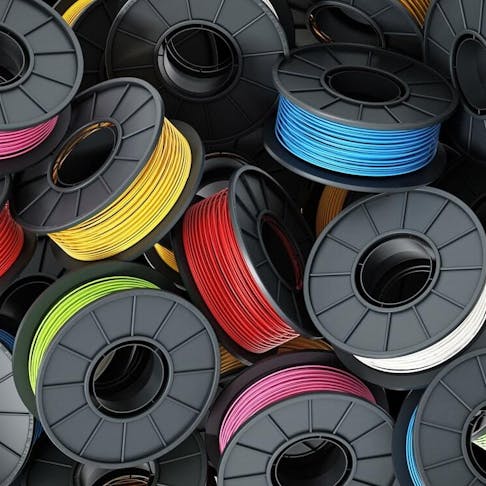PETG, which stands for polyethylene terephthalate glycol-modified, and PLA, meaning polylactic acid, are both thermoplastics, used a lot in 3D printing, also known as additive manufacturing. While we only directly offer PLA at the moment here at Xometry, knowing about both of these materials is important to help you understand what options are out there. There are good reasons why both of them are so popular. They’re compatible with most machines, can both be colored or made transparent, and they’re relatively inexpensive. This article will compare these two materials, but for more detailed descriptions and explanations of each, you can read our dedicated articles:
What is PLA?
PLA has been around for a very long time. It dates back to the 1930s when it was initially discovered at a DuPont lab. It only became available commercially in the 1980s, though, by Cargill Inc. It’s a polymer (essentially a polyester) that’s related to PET (polyethylene terephthalate). “PLA is a bioplastic made from a variety of plant-based materials originally developed as a biodegradable plastic for single use and other applications,” says Christian Tsu-Raun, the Manual Quoting Team Lead here at Xometry. “Desirable 3D printing attributes are rigidity, low cost, and speed of printing.” The lactic acid it contains can come from pretty much anywhere suitable, including both natural and renewable sources like corn starch and sugar cane. At Xometry, we offer PLA in blue, black, white, and red, as shown in the image below:

Benefits
- Makes parts with great cosmetic quality with FDM (fused deposition modeling) printers
- Ease to post-process and hand-finish prints
- Keeps part accuracy as it has a low chance of warping
- Affordable
- Low viscosity at the nozzle
- Low melting point
- Cools to a hard and durable finish
- Good for hobbyists as well as professionals
Disadvantages
- Parts are more susceptible to moisture and UV
- Less temperature stable than other options
- Not the strongest material (could fracture when bent or twisted)
- It’s anisotropic as its interior layers don’t bond as well as other materials
What is PETG?
The “PET” in PETG is a polyester (DuPont Dacron); this was first discovered in 1931, after which it was commercialized as Terylene. The “G” is for glycol, which was added to improve the material’s thermal properties by creating a less uniform polymer chain. “The glycol added stabilizes it and lowers the melting temperature,” Christian tells us. This also lowers the residual stress from cooling. Unlike PLA, PETG is made from materials that derive from crude oil.

Download Our FREE FDM Design Guide
Benefits
- Very flexible
- Fairly chemically stable
- High impact strength (less likely to fracture)
- Abrasion-resistant and tough
Disadvantages
- Not easy to sand
- Needs to be printed at a high temperature (could contribute to machine wear and longer cycles of warming up and cooling down)
- Highly viscous so prone to stringing (needs to be printed slower)
- More expensive than PLA and not as environmentally friendly
| Attribute | PETG | PLA |
|---|---|---|
Attribute Typical Tensile Strength (Yield) | PETG 50 MPa | PLA 57.4 MPa |
Attribute Typical Elongation at Break % | PETG ~130% | PLA 1.9%-4% |
Attribute Cosmetic Quality | PETG Fair | PLA Excellent |
Attribute Tendency to String or Ooze | PETG High | PLA Low |
Attribute Typical Cost per Kilogram | PETG $15–$25 per kg | PLA $12–$20 per kg |
Attribute Easy to Post-Process/Sand | PETG No | PLA Yes |
Attribute Applications | PETG Good for parts that need to be exposed to chemicals, wear, contact with other components, water, sun, and heat | PLA Low-stress cosmetic use and parts that require a better finish quality |
Attribute Printing Speed | PETG Slower, with longer warm-up and cool-down times | PLA Faster |
Attribute Melting Point | PETG Between 220°C and 250°C | PLA Between 180°C and 210°C |
PETG vs. PLA Comparison Note: The values in this table are for reference only and are based on data from various providers. For more specific information, we recommend checking manufacturer-provided data sheets.
FAQs on PETG and PLA
Are these materials biodegradable?
Short answer? Not really. But it’s not as simple as that. As a chemically stable petroleum-based plastic, PETG is definitely not biodegradable. Its lifespan in landfills is measured in centuries. PLA, though, was designed and advertised as a “green” substitute for PET because it can degrade quickly. It’s made from renewable resources, so it can biodegrade in a few months or even weeks… but there’s a caveat: it has to be taken to an industrial composting facility and undergo the correct procedure. Otherwise, it could take decades to break down.
Are there any mutual alternatives to these materials?
Of course. Plenty of other thermoplastics can be used with FDM 3D printing, but those that can be fairly compared to PLA and PETG are:
ABS (acrylonitrile butadiene styrene): This can make high-strength parts of decent quality, but the risk of warping is a little higher, especially for desktop machines. We recommend using an enclosed build chamber, but that makes it harder to work with. At Xometry, ABS-M30 is one of the most popular general-purpose FDM materials we have.

ASA (acrylonitrile styrene acrylate): This is related to ABS, but it has better UV resistance, so it’s perfect for outdoor use. We offer this in lots of colors.

PC (polycarbonate): Another material we offer, PC is known for having amazing impact resistance, strength, and chemical compatibility. But PC can be a nightmare to work with because of its high extrusion temperature requirements, among other things. We use big industrial machines which are fine, but it’s not ideal if you’re working with a desktop machine.

Is PCTG a good alternative to PETG?
Yes. PCTG stands for polycyclohexylenedimethylene terephthalate—no that’s not a typo. It offers higher bonds, tensile strength, and clarity and can even print matte or gloss depending on the temperature of the extruder. Talking of temperatures, PCTG requires a 250–270°C nozzle temperature and many printers can’t reach that high.
What is PLA+?
PLA+ refers to a family of materials that are easy to print with—they’re basically PLA with benefits. The plus types have additives that enhance some of their properties, like calcium carbonate (improved tensile strength), carbon fibers (better flexural strength), metal flakes (a metallic aesthetic), and nucleating agents (better bonding of layers). These additives might make the perks go up, but so does their price tag.
How Xometry Can Help
Still have questions about PETG or PLA? Then reach out to one of our representatives. We also offer lots of manufacturing services including CNC machining, laser cutting, and, of course, 3D printing. You can quickly and easily upload your designs to our website and get your free, no-obligation quote today.
Disclaimer
The content appearing on this webpage is for informational purposes only. Xometry makes no representation or warranty of any kind, be it expressed or implied, as to the accuracy, completeness, or validity of the information. Any performance parameters, geometric tolerances, specific design features, quality and types of materials, or processes should not be inferred to represent what will be delivered by third-party suppliers or manufacturers through Xometry’s network. Buyers seeking quotes for parts are responsible for defining the specific requirements for those parts. Please refer to our terms and conditions for more information.


